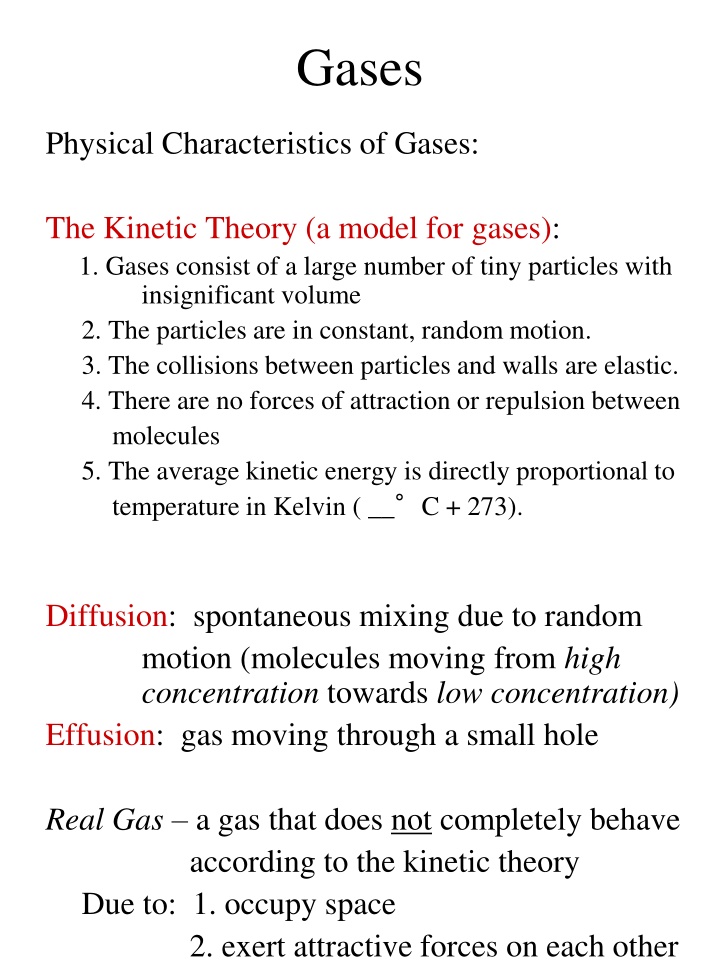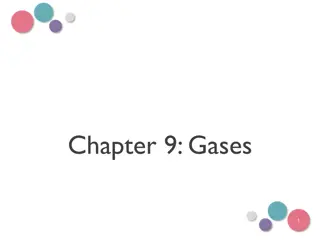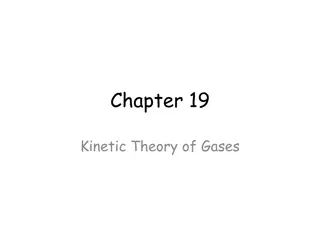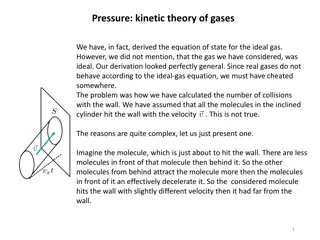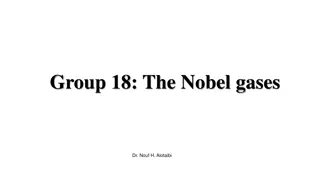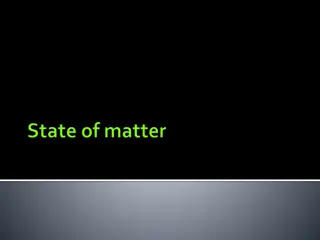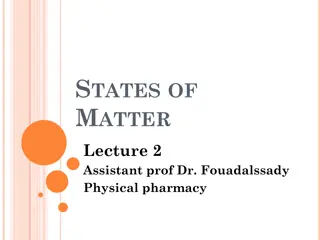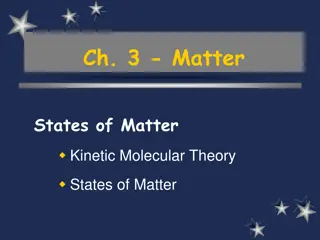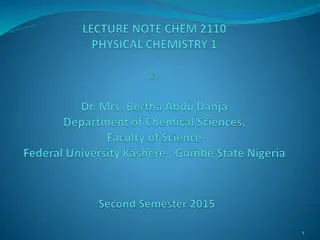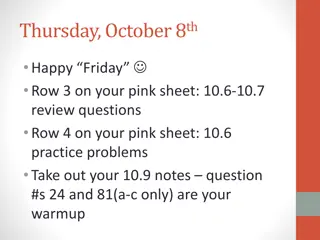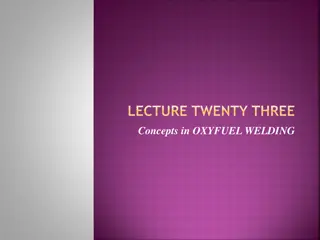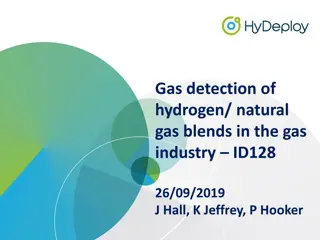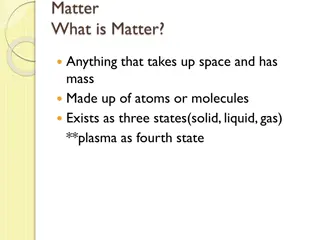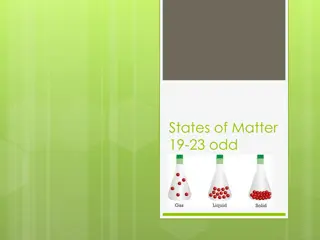Physical Characteristics and Laws of Gases: Kinetic Theory and Gas Properties
Explore the physical characteristics of gases, including the Kinetic Theory model, diffusion, effusion, real gases, and properties like pressure, volume, temperature, and number of moles. Discover Boyle's Law, Charles's Law, and practical gas volume calculations. Unveil the key principles of pressure, volume, and temperature relationships in gases with easy-to-understand examples.
Download Presentation

Please find below an Image/Link to download the presentation.
The content on the website is provided AS IS for your information and personal use only. It may not be sold, licensed, or shared on other websites without obtaining consent from the author.If you encounter any issues during the download, it is possible that the publisher has removed the file from their server.
You are allowed to download the files provided on this website for personal or commercial use, subject to the condition that they are used lawfully. All files are the property of their respective owners.
The content on the website is provided AS IS for your information and personal use only. It may not be sold, licensed, or shared on other websites without obtaining consent from the author.
E N D
Presentation Transcript
Gases Physical Characteristics of Gases: The Kinetic Theory (a model for gases): 1. Gases consist of a large number of tiny particles with insignificant volume 2. The particles are in constant, random motion. 3. The collisions between particles and walls are elastic. 4. There are no forces of attraction or repulsion between molecules 5. The average kinetic energy is directly proportional to temperature in Kelvin ( __ C + 273). Diffusion: spontaneous mixing due to random motion (molecules moving from high concentration towards low concentration) Effusion: gas moving through a small hole Real Gas a gas that does not completely behave according to the kinetic theory Due to: 1. occupy space 2. exert attractive forces on each other
SOLID Has its own shape Highest density Not compressible Little movement LIQUID Takes shape of container Middle density Not compressible Some movement GAS Fills container Lowest density Compressible Rapid movement
Properties (P,V,T,n) Pressure (P): force that a gas exerts on a given area 1 atm = 760 torr = 760 mmHg Volume (V): space occupied by gas 1 L = 1000 mL = 1000 cm3 Temperature (T): measure of the average kinetic energy of the gas MUST be in Kelvin! K = C + 273 Number of moles (n): quantity of gas molecules
What is Pressure? force Newtons = = pressure 2 area cm Changing the force or area will change the pressure (shoes!) Atmospheric (air) pressure is measured by a barometer: vacuum mercury atmospheric pressure 1 atm = 760 torr = 760 mmHg =1.013 x 105Pa =101.3 kPa STP: standard temperature and pressure. 1 atm and 0 C
Boyles Law V P = P V 1 1 2 2 When T is constant: inverse relationship between P and V (one goes up the other goes down) A sample of oxygen gas occupies a volume of 20 mL at 2.0 atm. At what pressure will it occupy 55 mL? P V 2.0 atm 20mL P = 1 V 1 = P2 2 55 mL 2 P2= 0.73 atm
Charless Law V= V 1 2 T T 1 2 When P is constant: direct relationship between V and T (one goes up the other goes up) = V 1 T T V 2 1 2
You get a 1.7 L balloon inside at a temperature of 23 C. At what temperature will the volume drop to 1.5 L ? Convert initial temperature to K T1= C + 273 = 23 + 273 = 296 K Rearrange equation V T 1 V T= T V= T V 1 2 = 1 2 T 1 V 2 2 V T 1 2 1 2 Solve for final temperature 296 K 1.5 L = 2 T 1.7 L T2= 26 1 K How cold is that?!?!
Gay-Lussacs Law P P= = 1 2 P T T P 1 2 1 2 T T 1 2 When V is constant: direct relationship between P and T (one goes up the other goes up) Higher T: more collisions in same area. A fire extinguisher has CO2 at 22 C and 20 atm. What is the pressure at 30 C? 295K 273 22 T 1 = + = = + = = P atm 0 2 1 = P ? T 30 273 303K 2 2 P= P 20 atm x 303 K P T = = 1 2 1 T 2 P 2 P 2 T T 295 K 1 2 1 P2= 21atm
Practice! Pages 419-425 #7-12,15-17 &20
Combined Gas Law V P = P V 1 T 1 2 T 2 1 2 True when moles are constant Use to remember Boyle s law: Charles s law: Gay-Lussac s law: A balloon has a volume of 20.0 L at 23 C and 770 torr. What will its volume be at 685 torr and 25 C? = = + = = T 23 273 296K P 770torr V 20.0 L 1 1 1 = + = = = T 25 273 298K P 685torr V ? 2 2 2 P T V P V P V = V 1 P 2 T 1 = 1 T 1 2 T 2 2 2 1 1 2 torr)(298 (770 K)(20.0 L) = = V2 L 3 2 torr)(296 (685 K)
Ideal Gas Law PV=nRT R is the gas constant. It will always have the same values. You must know which one to use R = 8.314 kPa L K-1 mol-1 if Pressure is in kilopascals(kPa), Volume is in liters(L), Temperature is in Kelvin(K) R = 0.0821 L atm K-1 mol-1 if Pressure is in atmospheres(atm), Volume is in litrers(L), Temperature is in Kelvin(K)
Ideal Gas Law What volume is needed to store 0.050 moles of helium gas at 202.6 kPa and 400 K? What pressure will be exerted by 20.16 g hydrogen gas in a 7.5 L cylinder at 20 C? A 50 L cylinder is filled with argon gas to a pressure of 10130.0 kPa at 30 C. How many moles of argon gas are in the cylinder? To what temperature does a 250 mL cylinder containing 0.40 g helium gas need to be cooled in order for the pressure to be 253.25 kPa?
Daltons Law of Partial Pressure P P P 1 Total + = + + P ... 2 3 The total pressure of a gas sample is equal to the sum of the partial pressures of individual gases. Example: Earth s atmosphere Gas Pressure (torr) N2 O2 Ar 593.5 159.2 7.1 CO2 Total 0.23 760
93.4 kPa 3.3 kPa
Gases You Know N2 The most common gas in our atmosphere (78%) Not reactive O2 20% of the atmosphere Supports combustion CO2 Greenhouse gas More dense than air Used in fire extinguishers H2 Very low density Explosive if mixed with O2
P T V Boyle s Law P T V Charles s Law
Vapor Pressure and Boiling Vapor Pressure the pressure exerted by a vapor in equilibrium with its liquid state. Liquid molecules at the surface escape into the gas phase. These gas particles create pressure above the liquid in a closed container.
The condition in which two opposing processes are occurring simultaneously at equal rates is called a dynamic equilibrium. A liquid and its vapor are in equilibrium when evaporation and condensation occur at equal rates. This can only be obtained in a closed container.
Vapor Pressure increases with increasing temperature. 80oC 20oC As temperature increases, the amount of vapor generated by a liquid in a closed container increases. This occurs because as the liquid gains kinetic energy, the molecules can overcome the
Evaporation vs Boiling Evaporation - when a liquid gas at any temperature Vaporization When a liquid gas when heat is applied or at the boiling temperature Boiling occurs when the vapor pressure above the liquid equals the atmospheric pressure.
Vapor Pressure Curves Graph shows how boiling points change with change in vapor pressure.
Boiling Points change with pressure changes.
